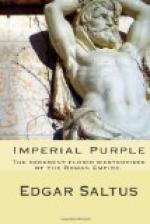Beyond the episode connected with Antinous, Hadrian’s journey was marked by another, one which occurred in Judaea. Both were infamous, no doubt, but, what is more to the point, both mark the working of the poison in the purple that he bore.
Since Titus had gone, despairful Judaea had taken heart again. Hope in that land was inextinguishable. The walls of Jerusalem were still standing; in the Temple the offices continued. Though Rome remained, there was Israel too. Passing that way one afternoon, Hadrian mused. The city affected him; the site was superb. And as he mused it occurred to him that Jerusalem was less harmonious to the ear than Hadrianopolis; that the Temple occupied a position on which a Capitol would look far better; in brief, that Jehovah might be advantageously replaced by Jove. The army of masons that were ever at his heels were set to work at once. They had received similar orders and performed similar tasks so often that they could not fancy anyone would object. The Jews did. They fought as they had never fought before; they fought for three years against a Nebuchadnezzar who created torrents of blood so abundant that stones were carried for miles, and who left corpses enough to fertilize the land for a decade. The survivors were sold. Those for whom no purchasers could be found had their heads amputated. Jerusalem was razed to the ground. The site of the Temple was furrowed by the plow, sown with salt, and in place of the City of David rose AElia Capitolina, a miniature Rome, whose gates, save on one day in the year, Jews were forbidden under penalty of death to pass, were forbidden to look at, and over which were images of swine, pigs with scornful snouts, the feet turned inward, the tail twisted like a lie.
It was not honorable warfare, but it was effective; then, too, it was Hadrianesque, the mad insult of a madman to a race as mad as he. The purple had done its work. History has left the rise of this emperor conjectural; his fall is written in blood. As he began he ended, a poet and a beast.
Presently he was in Rome. It was not homesickness that took him there; he was far too cosmopolitan to suffer from any such malady as that. It was the accumulations of a fifteen-year excursion through the metropoles of art which demanded a gallery of their own. Another with similar tastes and similar power might have ordered everything which pleasured his eye to be carted to Rome, but in his quality of artifex omnipotens Hadrian embellished and never sacked. There were painters and sculptors enough in that army at his heels, and whatever appealed to him was copied on the spot. So much was copied that a park of ten square miles was just large enough to form the open-air museum which he had designed, one which centuries of excavation have not exhausted yet.




